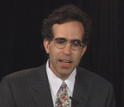|

Discovery
Math Could Aid in Curing Cancer

Scientists and medical doctors couple math and medicine for unusual, promising marriage
August 4, 2008
When kids complain that math homework won't help them in real life, a new answer might be that math could help cure cancer. In a recent study that combined math and medicine, researchers have shown that patients with chronic myelogenous leukemia (CML) may be cured of the disease with an optimally timed cancer vaccine, where the timing is determined based on their own immune response. The researchers' findings were reported in the June 20 edition of the journal PLoS Computational Biology. In their paper, Doron Levy, University of Maryland associate professor of mathematics; Peter P. Lee, Stanford Medical School physician and associate professor of medicine (hematology); and Peter S. Kim, École Supérieure d'Électricité (Gif-sur-Yvette, France) describe their success in creating a mathematical model that predicts anti-leukemia immune response in CML patients using the drug Imatinib can be stimulated in a way that might provide a cure for the disease.
| -- |
Lisa-Joy
Zgorski, National Science Foundation (703) 292-8311 lisajoy@nsf.gov
|
Investigators
Doron Levy
Peter P. Lee
Peter S. Kim
Related Institutions/Organizations
University of Maryland College Park
Stanford University
École Supérieure d'Électricité
Locations
Maryland
California
France
Related Programs
Applied Mathematics
Signal Processing Systems
Computational Mathematics
Related Awards
#0133511 CAREER: Partial Differential Equation-based Image Processing with Applications to Radiation Oncology
#0820817 CAREER: Partial Differential Equation-based Image Processing with Applications to Radiation Oncology
Total Grants
$407,349
Related Agencies
American Cancer Society
National Cancer Institute
Related Websites
Media accessible paper in June 20, PLoS: http://www.plos.org/press/plcb-04-06-20-levy.pdf
Eureka Alert Press Release (full): http://www.eurekalert.org/pub_releases/2008-06/uom-mch061908.php
|




